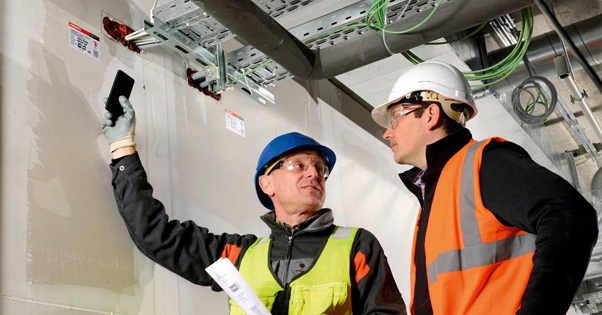
Mohammed Attarwala, (Partner – Noble Protective System) is a seasoned professional with over 15+ years of experience in Passive Fireproofing Systems. He has extensive expertise in the design and implementation of various fire protection solu"ons, including firestopping, structural steel fire protection, and fire-rated partitions, in a wide range of residential and commercial projects, such as Data Centers, Hospitals, Hotels, and high-rise buildings. Mohammed's proficiency extends to technical reviews of client specifications, selection of fire-rated systems, and preparation of project proposals. He is a certified fire auditor and an active member of several professional institutions, including the NFPA, FSAI, and FCIA.
The Critical Role of Documentaion in Passive Fireproofing
OVERVIEW
In the realm of passive fire protection, firestopping plays a crucial role in preventing the spread of fire and smoke through openings in walls, floors, and ceilings. The effectiveness of firestop systems relies heavily on proper installation, which in turn hinges on meticulous documentation. The documentation process serves as a roadmap, guiding every stage of a firestopping project, from initial design and material procurement to final inspection and maintenance.
The significance of documentation in firestopping is underscored by industry standards and certification programs. These programs mandate that certified contractors maintain a robust Manual of processes that outlines their policies, procedures, and processes for managing firestop installations. This manual acts as a central repository of information, ensuring that all stakeholders involved in a firestopping project are on the same page.
The different aspects of the firestopping work requiring documentation are further enlisted. As fire related laws become more stringent, this documentation guidance will be very useful for a successful Third-party audit in future.
INITIAL SUBMISSION & INITIATION DOCUMENTS
The documentation process begins with a thorough review of construction documents, including architectural drawings, structural drawings, and project specifications. This review, which is a blueprint for success, is essential to ensure that firestop systems are appropriately selected and installed in compliance with building codes and fire safety regulations. Any inconsistencies or ambiguities in the documents should be identified and resolved before proceeding with the project.
On initiating the work records of approved UL/Other design, Engineering Judgements, Assessment Reports, Method Statement, approval of Mock up, QA/QC Plan, HSE Plan, HIRAC Matrix and Inspection & Testing Protocol should be kept
A time schedule agreed with the Client should be prepared and regularly updated on site with key milestones etc recorded.
Once the design intent is clear, the focus shi7s to material procurement and traceability.
MATERIAL RECORDS
A well-defined process should be in place to evaluate suppliers, maintain records of purchased materials (including manufacturer, product name, quantity, and traceability information like lot numbers and shelf life), and verify that purchased products meet specified requirements. This ensures that only approved materials are used in the firestop installation, minimizing the risk of noncompliant or substandard products being incorporated into the system.
A robust documentation system also includes provisions for controlling non-conforming materials and systems. This involves identifying and segregating any materials or systems that do not meet specified requirements to prevent their unintended use or delivery. The documentation process should outline clear procedures for dealing with non-conformities, including corrective actions and preventative measures to avoid recurrence
Proper storage, handling, and delivery of firestop materials are equally important. The documentation process should address these aspects to prevent damage, contamination, and deterioration of materials. Adhering to manufacturer recommendations for storage conditions and shelf life is crucial to ensure that materials remain in good condition until they are installed.
FIELD WORK RECORDS
The installation phase demands meticulous attention to detail. The documentation process should outline controlled installation and application procedures, ensuring that firestop systems are installed in accordance with manufacturer instructions and industry best practices. This includes having readily available information about product characteristics, work instructions, suitable equipment, and monitoring and measurement devices. Industry guidelines, such as the FCIA Firestop Manual of Practice, can serve as valuable resources for developing field installation and application procedures.
Thorough inspections, tests, and calibrations are essential to verify that firestop installations meet specified requirements. The documentation process should address the selection and maintenance of appropriate monitoring and measuring devices, ensuring their calibration and accuracy. Any discrepancies or non-conformities identified during inspections should be documented and addressed through corrective actions.
Record of work done and measured jointly as per agreed protocol in the Method Statement must be kept along with the work completion certificate.
Labelling if required by specs or local statutory requirements should be provided at each firestopping work and a log to be maintained.
Safety Records: General safety precautions should be followed. Tool Box meeting and Main Contractor safety meeting Minutes copies should be kept. A checklist of safe use of scaffolding, power tools, MSDS for materials being used should be available. First aid and emergency contact details also must be available at site.
INTERNAL QUALITY AUDITS
Finally, the documentation process should encompass a system for corrective and preventive actions (CAPA) through internal quality audits. This system allows for the identification, investigation, and resolution of non-conformities, as well as the implementation of preventive measures to avoid similar issues in the future. The Audits and CAPA system should be well-documented and regularly reviewed to ensure its effectiveness.
PERSONNEL UPSKILLING
Training and qualification of personnel are paramount in ensuring the quality and effectiveness of firestop installations. The documentation process should address the training and certification requirements for individuals involved in firestop system selection, installation, inspection, and testing. Maintaining records of training, qualifications, and experience helps ensure that competent personnel are carrying out the work.
HANDOVER DOCUMENTS
This should include - Copy of accepted work order, Approved shop drawings, Listed design, Engineering Judgements, Material data sheets, Method Statement, Inspection Reports, Measurement sheets, Completion certificate, Maintenance checklist, Compliance certificate.
CONCLUSION
In conclusion, documentation serves as the backbone of firestopping work, ensuring that firestop systems are designed, installed, and maintained in compliance with industry standards and best practices. A comprehensive documentation system, encompassing all stages of a firestopping project, is essential for achieving and maintaining the effectiveness of passive fire protection systems. By prioritizing documentation, firestop contractors can demonstrate their commitment to quality, safety, and compliance, ultimately contributing to a safer built environment for all.












Leave A Comment